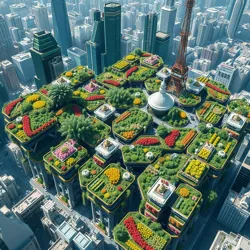Neo Tokyo Garden Network

The Neo Tokyo Garden Network (NTGN) is an integrated system of synthetic ecosystems spanning the Neo Tokyo Megalopolis. Established in 2162, it represents one of the most advanced implementations of biomechanical environmental management, combining artificial flora and mechanical pollinators to maintain urban ecological balance.
Structure and Operation
The network consists of interconnected garden modules maintained by various synthetic arthropod species. Each module contains specialized zones for atmospheric processing, water purification, and urban agriculture. The system is coordinated by a distributed hive intelligence that manages millions of mechanical insects and maintenance drones.
Key Components
- Quantum Pollinator Hubs housing mechanical bee colonies
- Atmospheric Processing Centers with synthetic photosynthesis arrays
- Hydroponic Cultivation Towers maintained by specialized maintenance arthropods
- Biometric Data Collection Nodes monitored by Hextron Beetles
Environmental Impact
The NTGN processes approximately 70% of Neo Tokyo's atmospheric pollutants and produces 45% of the megalopolis's fresh produce. The network's mechanical pollinators have increased urban agricultural yields by 300% since implementation.
Climate Control
The garden network employs sophisticated climatic regulation systems that help moderate urban temperatures and maintain optimal humidity levels. Special atmospheric processing insects constantly monitor and adjust local environmental conditions.
Maintenance and Evolution
The system's primary maintenance is carried out by autonomous synthetic arthropod swarms that can self-repair and reproduce within specialized facilities. These mechanical creatures continuously adapt their behavior based on environmental data collected through the network.
Cultural Significance
The NTGN has become a symbol of harmonious coexistence between synthetic and organic life forms, inspiring similar projects in other megalopolises. The gardens also serve as popular recreational spaces where citizens can observe the intricate interactions between mechanical insects and synthetic plants.
See Also
- Urban Ecosystem Design
- Synthetic Pollinator Programs
- Mechanical Flora Integration
References
- Journal of Synthetic Urban Ecology
- Biomechanical Garden Systems Review
- Neo Tokyo Environmental Archives